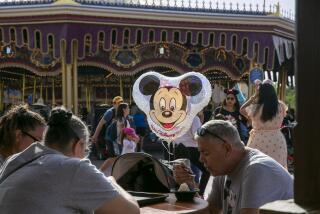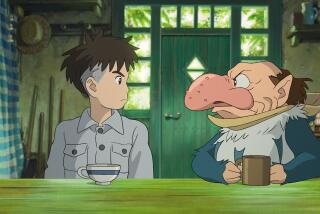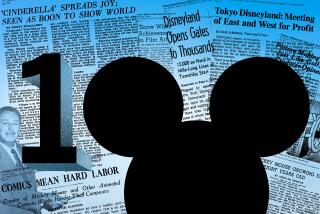Selling of the Cel: Disney to Market Computer Images
BURBANK — The Walt Disney Co. is about to change the ‘toon of the $100-million-a-year-trade in animation cels--the colorful paintings that, until Disney used a sophisticated new computer program to make its blockbuster “Beauty and the Beast,” were the handmade individual building blocks of all cartoons from “Steamboat Willie” to “The Simpsons.”
The company is preparing to market cels from “Beauty” that were never used to make the movie itself. The studio that pioneered animated features with scores of “ink-and-paint ladies” tracing drawings and then hand-painting thousands of individual cels has now delegated those expensive jobs to its new computer system.
The result?
A boundless new frontier for animation. Critics and animators agree that the revolutionary ability to manipulate cartoon images digitally will produce animation never before thought possible, and at lower cost.
The rub?
Images that exist only as the binary zeros and ones of a computer’s memory. Because they are electronically transferred to film, they bypass the traditional steps of creating and filming production cels.
The remedy?
Disney is manufacturing so-called “created” cels and hand painting them solely for the fast-growing, lucrative collecting market. It’s a huge collectibles business of original and limited-edition artworks with more than 350 galleries across the country and multimillion-dollar sales by the same auction houses that sell Rembrandts and Picassos.
Sotheby’s auction house in New York is expected to announce plans today for a special sale of the specially created artwork from “Beauty” to be held later this year.
“I think it’s a great irony that just at the moment that the animation industry is trying to phase out cels, the cels have never been more valuable and desirable,” said film critic Leonard Maltin, a collector and author of “Of Mice and Magic,” about the history of Disney animation. “It’s pretty amusing actually.”
Disney, which sells animation artwork through its studio art program and more than 100 Disney stores worldwide, has good reason to keep the animation art market alive. So for the Sotheby’s auction, Disney will be combining its created cels with original backgrounds hand-painted for use in “Beauty” to re-create scenes as they appeared in the movie.
Serious collectors and gallery owners say created cels will drive up the value of vintage cels from animation past, as more and more of the industry moves over to computers.
“Computers may diminish the production of new animation art but in no way will diminish the collectibility or the value of existing animation art,” said Michael Halbreich of the Cricket Gallery in Atlanta. “Just the opposite. Hand-painted art will be much more sought after, and existing quality animation art will remain extremely desirable and become extremely more valuable.”
But some collectors are concerned that an unsuspecting public will be duped into believing that the cel reproductions Disney has planned were used in the making of movies.
“It will confuse the less-sophisticated buyers because they’ll all think there are production cels, and there are not,” said Gregg Medlyn, owner of the Fine Toon gallery in Houston. “I had a big problem with people going to the MGM Studios in Florida and telling me they saw ‘cels’ on display from ‘Beauty and the Beast.’ I even had to call Disney to find out what was on display there.
“They were actually color model cels. Disney hand-painted some cels to get the colors down right to compare them to the computer colors. But everybody thought they were seeing real production cels.”
Traditionally, animators’ pencil drawings were traced or photocopied onto celluloid and then painstakingly colored by hand. Now, on feature films, Disney digitally scans the pencil drawings into a computer, which paints them in electronic strokes of vivid colors. The time-saving and money-saving procedure has revolutionized the industry, as companies using computer-assisted animation techniques are being contracted for work throughout Hollywood.
But while Disney is significantly changing the rules of animation with computers, the studio has been acting as if nothing has happened. The 41-page press book that Disney sent out for the release of “Beauty” reported that “226,000 individually painted cels” were used in making the picture--even though the images seen on screen were not “painted” in the traditional sense by human hands and do not physically exist on celluloid or “cels.”
“When I first read that I thought, ‘Ah, so there were production cels used in the movie,’ ” said Dawn Altyn, a reporter for In Toon magazine, which reports on animation art. “Later I called Disney and they told me no, there were no production cels.”
A spokeswoman for Disney’s art program turned down repeated requests for a Disney official to comment for this story.
Art dealers and collectors are looking to the Sotheby’s auction to see how the market will react to the created cels. “It could confuse the marketplace, because there’s no such category right now,” said Carol Nishi, director of animation for Circle Fine Art Corp. in City of Industry. “If there aren’t any production cels from ‘Beauty and the Beast,’ I think this will be fine as long as they hand out a brochure or something to inform the public that this is a new product.”
The growing animation art market, a cottage industry just a few years ago, is now being regarded with renewed interested by legions of serious collectors. The Animation Art Guild in New York, which tracks the activities of 350 galleries in the United States and Canada, estimates the North American market to be as high as $100 million a year. Animation art galleries are also springing up in Europe, Japan and Australia, and the first European animation auction was held last week at Christie’s in London.
Disney showed that contemporary animation art could sell as well as vintage art in 1989 when Sotheby’s auctioned 350 original production cels from “Who Framed Roger Rabbit” for a healthy $1.6 million. A year later “The Little Mermaid” sold 350 cels and backgrounds for $1.2 million.
This time, Disney is mounting the created “Beauty” cels over production backgrounds painted by Disney artists so collectors can obtain original artwork that was used in the movie--background paintings are considered valuable because they come directly from the animators’ hands. One dealer of vintage animation, however, cautioned prospective buyers to look closely at what they’re paying for.
“Disney auctioned ‘Little Mermaid’ underwater backgrounds that were generic, non-specific, hard to recognize and nebulous,” said Ron Silverstein, owner of Silverstone Gallery in Long Beach. “The sea backgrounds were the same level as the cels they were selling, which were not the Grade-A cels. The backgrounds were used in the film, but they were not pristine backgrounds.
“My gut says if they’re going to sell backgrounds (from “Beauty”), they may not be the wonderful backgrounds you envision from the film. Some of the most miraculous background scenes,” he said, referring to such examples as the widely viewed ballroom dance sequence, “were done in the computer, just like the cels were.”
Nevertheless, animation dealers agree that the appetite for “Beauty” art is huge. “Beauty” is the top-grossing animated film of all time with $130 million in box-office revenues. When “Beauty” hits the videocassette market in October, Disney expects unit sales to surpass the 14.2-million mark set by “Fantasia” to become the biggest-selling video in history.
“Based on my experience and knowledge of the market, I’ll say that these pieces will be every bit as sought after as Disney production cels,” Halbreich said, “because they are indeed being made from the original animator’s pencil drawing. The only difference between them and production cels, which are now being done by computer, is that they didn’t go under the camera to be photographed.”
More to Read
The biggest entertainment stories
Get our big stories about Hollywood, film, television, music, arts, culture and more right in your inbox as soon as they publish.
You may occasionally receive promotional content from the Los Angeles Times.










